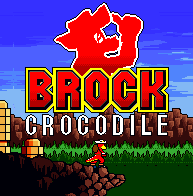Developer’s Blog #5: The sounds of Brock Crocodile
April 20, 2015

For Brock Crocodile, I’ve been trying to stay as authentic as possible to the original MegaDrive/Genesis hardware. I’ve been using the Sega MegaDrive/Genesis audio set up, which is 6 channels of FM synthesis + 4 channels of PSG through a free tracker program. Once I’ve programmed the notes to my liking, I’ve been exporting them to a flash cartridge and recording the music directly from the console itself. This ensures that what you hear can be played back on the console itself – 100% authentic! This does not come without cost, however, as while the tracker is a great program for creating MD/GEN music, it doesn’t always translate exactly when played on the console, which leads to lots of tweaking. Just ask the staff how frustrated I get with it (well, that and frying systems – maybe that’s a topic for another post? 😉 )
So, what is FM synthesis? The non-technical terms would be “the unique boingy-springy sound that you’re used to when you hear MD/GEN music”. It’s that twangy bass, the bounce off a spring in Sonic the Hedgehog, the raw and dirty guitar sounds in Comix Zone, the gentle sounds of Phantasy Star IV’s town themes, and everything in-between. Many of the MD/GEN’s direct competition – such as the NES and the Turbografx-16/PC-Engine – used waveform based sound generators (IE square waves, sawtooth waves, triangle waves, or customizable wavetables). The Super Nintendo used a sample based sound generator that allowed for lush and diverse tones but did so at the cost of clarity, which just happens to be the MD/GEN’s forte. While it is limited by the very design of FM itself, the YM2612 (the soundchip inside the MD/GEN) is easily manipulated into convincing guitar, string, brass, and woodwind sounds. A great example of all these diverse sounds in motion would be Michiru Yamane’s Castlevania Bloodlines:
As for drums, the Sega MD/GEN is capable of turning the 6th FM channel into an 8bit sample channel. I can basically convert and drop any sounds I want into it. However, I find that it’s more interesting to create my own drum sounds using the FM since they are clearer, louder, and bolder. In fact, in the Bloodlines example above, Yamane doesn’t use a single sample drum! That’s all FM! It can be very convincing. That being said, you’ll still hear an occasional “Sonic Drum” in my work. It’s iconic and sometimes it’s exactly what the music needs.
Accompanying the YM2612 inside the MD/GEN is a sort of…. dinosaur from a “forgotten” era. The MD/GEN’s mainboard, especially in the case of the very first models, is completely based off the Sega Master System’s… so much so that the system INCLUDES the Master System’s main chip and sound capabilities. This is why, with a Power Base Converter, you can easily run old Master System games – the Master System is inside the MD/GEN basically! The SMS side of things provides me with an extra 4 channels of sound- 3 of pure tone square waves, and one noise channel. It can be manipulated to make periodic noise and all kinds of interesting sounds, though it was rarely done in the SMS games of old. To hear it in action on the MD/GEN, you need only to listen to the background figures of this iconic track from Sonic 3:
Most of the high-pitched, pure, light responses in the background are from the SMS’s old programmable sound generator! You’ve been hearing the Sega Master System this whole time and didn’t know!
All and all, I’m very excited to be able to bring you guys an authentic MegaDrive/Genesis experience. I hope my music brings back as much nostalgia for you as it has for me during this whole process. I can’t wait to share the whole soundtrack when it’s done! Let’s get this Greenlit!

